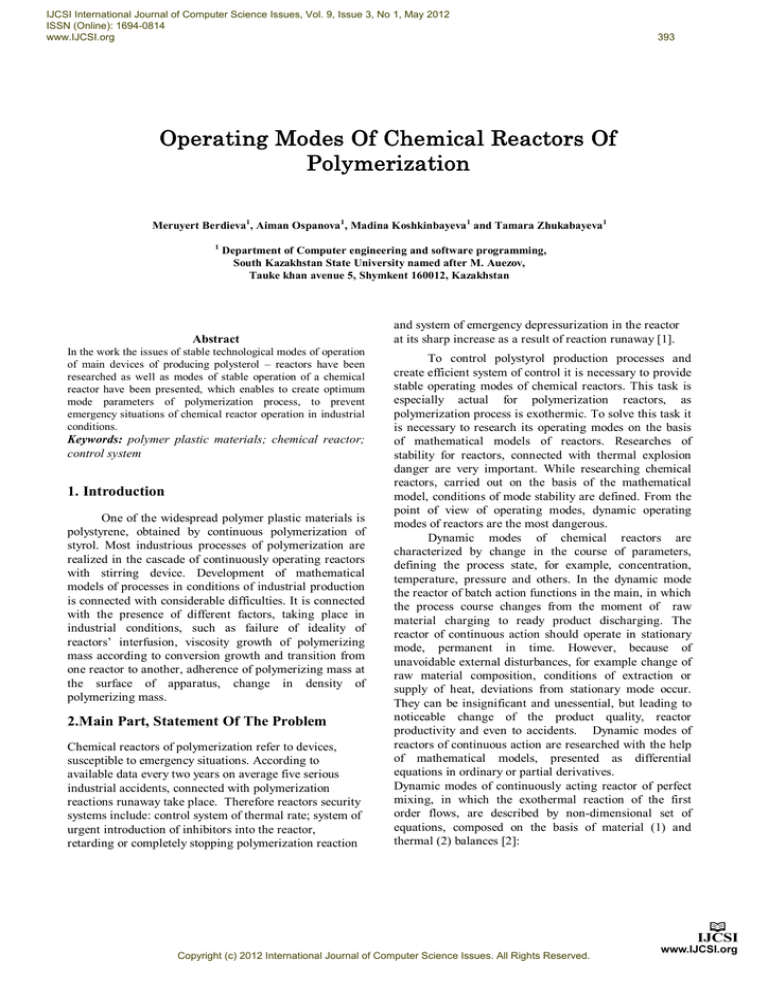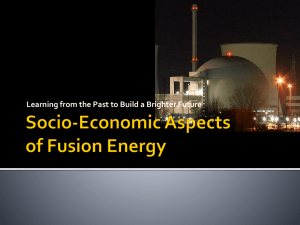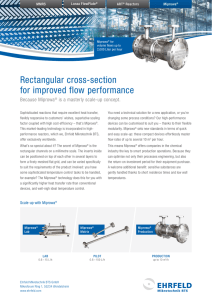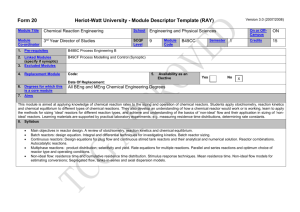Operating Modes Of Chemical Reactors Of Polymerization
advertisement

IJCSI International Journal of Computer Science Issues, Vol. 9, Issue 3, No 1, May 2012 ISSN (Online): 1694-0814 www.IJCSI.org 393 Operating Modes Of Chemical Reactors Of Polymerization Meruyert Berdieva1, Aiman Ospanova1, Madina Koshkinbayeva1 and Tamara Zhukabayeva1 1 Department of Computer engineering and software programming, South Kazakhstan State University named after M. Auezov, Tauke khan avenue 5, Shymkent 160012, Kazakhstan Abstract In the work the issues of stable technological modes of operation of main devices of producing polysterol – reactors have been researched as well as modes of stable operation of a chemical reactor have been presented, which enables to create optimum mode parameters of polymerization process, to prevent emergency situations of chemical reactor operation in industrial conditions. Keywords: polymer plastic materials; chemical reactor; control system 1. Introduction One of the widespread polymer plastic materials is polystyrene, obtained by continuous polymerization of styrol. Most industrious processes of polymerization are realized in the cascade of continuously operating reactors with stirring device. Development of mathematical models of processes in conditions of industrial production is connected with considerable difficulties. It is connected with the presence of different factors, taking place in industrial conditions, such as failure of ideality of reactors’ interfusion, viscosity growth of polymerizing mass according to conversion growth and transition from one reactor to another, adherence of polymerizing mass at the surface of apparatus, change in density of polymerizing mass. 2.Main Part, Statement Of The Problem Chemical reactors of polymerization refer to devices, susceptible to emergency situations. According to available data every two years on average five serious industrial accidents, connected with polymerization reactions runaway take place. Therefore reactors security systems include: control system of thermal rate; system of urgent introduction of inhibitors into the reactor, retarding or completely stopping polymerization reaction and system of emergency depressurization in the reactor at its sharp increase as a result of reaction runaway [1]. To control polystyrol production processes and create efficient system of control it is necessary to provide stable operating modes of chemical reactors. This task is especially actual for polymerization reactors, as polymerization process is exothermic. To solve this task it is necessary to research its operating modes on the basis of mathematical models of reactors. Researches of stability for reactors, connected with thermal explosion danger are very important. While researching chemical reactors, carried out on the basis of the mathematical model, conditions of mode stability are defined. From the point of view of operating modes, dynamic operating modes of reactors are the most dangerous. Dynamic modes of chemical reactors are characterized by change in the course of parameters, defining the process state, for example, concentration, temperature, pressure and others. In the dynamic mode the reactor of batch action functions in the main, in which the process course changes from the moment of raw material charging to ready product discharging. The reactor of continuous action should operate in stationary mode, permanent in time. However, because of unavoidable external disturbances, for example change of raw material composition, conditions of extraction or supply of heat, deviations from stationary mode occur. They can be insignificant and unessential, but leading to noticeable change of the product quality, reactor productivity and even to accidents. Dynamic modes of reactors of continuous action are researched with the help of mathematical models, presented as differential equations in ordinary or partial derivatives. Dynamic modes of continuously acting reactor of perfect mixing, in which the exothermal reaction of the first order flows, are described by non-dimensional set of equations, composed on the basis of material (1) and thermal (2) balances [2]: Copyright (c) 2012 International Journal of Computer Science Issues. All Rights Reserved. IJCSI International Journal of Computer Science Issues, Vol. 9, Issue 3, No 1, May 2012 ISSN (Online): 1694-0814 www.IJCSI.org dx xe d dy xe d 1 y ( x 0 x ); (1) 1 y ( y 0 y) ( y y) where х, у – variables, proportional according to concentration of reacting substance and temperature in the reactor; x0, y0 – the very variables for the flow at the entry of the reactor; ут – variable, proportional to the temperature of the environment; υ – constant, proportional to the flow rate at the entry of the reactor; ω – constant, proportional to the heat transfer coefficient and surface area of heat exchange with the environment; τ – time. One of the efficient and demonstrative methods of researching dynamic modes of chemical reactors is the method of phase planes. Phase coordinates herein are variables x and у. The whole total of trajectories, responding to various primary conditions, is the phase portrait of the system, uniquely reflecting dynamic modes [3]. Stability researches of stationary states are one of the main tasks of studying dynamic modes. Stationary states of the reactor are given in the phase portraits by the points А, В, С (Picture 1). If the trajectory aspires to the stationary state, it is stable and the reactor mode is operable. If the process in the chemical reactor is stable, phase trajectories must approach to these points. The direction of reactor mode change is pointed out with arrows. If the trajectory comes out of stationary state, it is unstable and phase trajectories in the course of time move away from stationary state. Phase portraits of the system, reflecting the most interesting dynamic modes of functioning chemical reactors are presented in Fig.1. Portrait 1a corresponds to the mode with the only stable stationary state t.А, while deviating from which variables х and у aspire to return to it, a type of the exceptional point – stable node. In portrait 1b the gyroidal character of trajectories means that the mode of approach to the only stationary state t.А is oscillating fading, that is stable focus. The trajectories in portrait 1c, responding to unstable condition t.А, move away from the stationary point of the trajectory and aspire to the closed trajectory G, called boundary cycle, corresponding to autooscillations. The motion of the representative point along G means 394 persistant oscillations х and у. Researching such modes (autooscillations) is one more task of studying dynamic modes. Portrait 1d corresponds to the mode with three stationary states, one of which is unstable. The case, when all stationary states are unstable, is principally possible. Herein they are covered by boundary cycle. у у А А М у(τк) а) х х(τк) b) у у G А В A c) А А х d) Fig. 1 Phase portraits of chemical reactors Stationary modes of the reactor are defined by the condition dx/dτ = dy/dτ = 0. The solution of equations system (1) gives the meaning xs and ys for the stationary state. Depending on the parameters of the reactor, stationary states can be one or three; in general case they are always odd number. The solution systems (1) are functions of time х(τ), y(τ) and primary conditions. The received algebraic equations show the connection of steady-state temperature in the reactor Ts with the temperature of entering mixture T0. To check the mode for stability, the first method of Lyapunov is used. For this purpose it is necessary to linearize equations (1), (2) in the neighborhood of the stationary state and receive linear equations in deviations χ = х-хs; ψ =y-ys,: Copyright (c) 2012 International Journal of Computer Science Issues. All Rights Reserved. IJCSI International Journal of Computer Science Issues, Vol. 9, Issue 3, No 1, May 2012 ISSN (Online): 1694-0814 www.IJCSI.org d a b; d d c d d (2) 395 autooscillations of reactors, the data have been written from control and measuring instruments at the instrumentation and automation section (Fig. 3). 280 The stability of linearized system of equations (2) is checked with the help of Rauss-Hurwitz criterion: 1 (a b) 0; Temperature, Т o C 215 (3) 2 (ad bc) 0 where a, b, c, d – Hurwitz coefficients. The analysis of these expressions (3) in the form of inequations allows to elucidate boundaries 2 0 , 85 20 15 1 0 and 16 17 18 19 20 21 22 23 Time, τ, hour which break phase plane into regions of various stationary states (Fig 2). х0 150 Fig. 3 Autooscillations of industrial reactors As seen in the picture, autooscillations have relatively permanent amplitude and frequency and are stable. The reactor performs autooscillations at the average temperature about 210оС. Oscillations of the temperature occur within the range 50оС, that is from 183оС to 233оС. Such temperature is typical for polymerization at the second level or in the second reactor. 2 Δ1=0 3 Δ1=0 3.Conclusion 1 у0 Fig. 2 Regions of various modes of the reactor The picture shows that the region of parameters plane х0, у0 is broken into regions of various number and stability of stationary states 1, 2 and 3. Phase portraits of such regions contain stable boundary cycles, that is the reactor has stable autooscillations, as presented in Picture 1c. The graphic of regions of various states (Fig.2) allows to forecast stability and the number of equilibrium states at various conditions of carrying on the process and various constructive parameters of the reactor and gives the broad picture about operating modes of the reactor work. The analysis of real conditions of polymers production in industrial reactors [4, 5] has showed the presence of The correctness of conclusions concerning the presence in reactors of stable autooscillations (Fig.2) coincides with the data from industrial reactors (Fig. 3). Thus, with the help of the phase space method, issues of stable technological modes of operation of main devices of producing polysterol – reactors have been researched. Modes of stable operation of the chemical reactor have been presented, which enables to create optimum mode parameters of polymerization process, to prevent emergency situations of the operation of chemical reactors in industrial conditions. References [1] [2] [3] [4] [5] Kramers Kh., Vestertep К. Chemical reactors. М.: Chemistry, 1967. 264p. Berlin Аl.Аl., Volfson С.А. Kinetic method in the polymers synthesis. М.: Chemistry, 1973. 360 p. Denbig К.G. The theory of chemical reactors. М.: Science, 1968. 120 p. Bolter B.V., Salnikov Ye.Т. Stability of operating modes of chemical reactors. – М.: Chemistry, 1981. – 44p. Ospanova А.О., Zhumadilova S.S. – Research of stability of chemical reactors for styrol polymerization. // National Copyright (c) 2012 International Journal of Computer Science Issues. All Rights Reserved. IJCSI International Journal of Computer Science Issues, Vol. 9, Issue 3, No 1, May 2012 ISSN (Online): 1694-0814 www.IJCSI.org [6] [7] [8] [9] [10] [11] [12] [13] scientific journal «Science and education of South Kazakhstan». - №23. 2001. p.181-185. Volfson S.А., Yenikolopyan N.S., Oshmyan V.G. Modelling polymerization processes in the cascade of thorough mixing reactors // Plastic masses. 1977, №1, p. 911 Gelperin N.I., Pebalk V.A., Konstanyan A.Ye. The structure of flows and efficiency of towers of chemical industry. М.: Chemistry, 1977.-273 p. Podvalnyi S.А. Modelling industrial processes of polymerization. М.: Chemistry, 1979. 255 p. Pavlov N.V. Peculiarities of styrol polymerization in suspension and the type of reactor: Works of TIChMa, edition 4, Tambov, 1970 Karpacheva S.М., Ryabchikov B.Ye. Oscillatory apparatus in chemical technology. М.: Chemistry, 1983. 224 p. Kafarov V.V., Dorokhov I.N. System analysis of processes of chemical technology: Fundamentals of strategy. М.: Science, 1976. Kafarov V.V., Dorokhov I.N. System analysis of processes of chemical technology: Topological principle of formalization. М.: Science, 1979.-400 p. Kafarov V.V., Dorokhov I.N., Dranishnikov T.V. System analysis of processes of chemical technology: Polymerization processes. М.: Science, 1991. -350 p. . Copyright (c) 2012 International Journal of Computer Science Issues. All Rights Reserved. 396




